Final report for SW15-003
Project Information
Medusahead is an invasive weed which threatens biodiversity, value of land and livestock operations in the channeled scablands of eastern Washington. Our research aimed at managing the nutritional environment to enhance medusahead use by cattle, thus creating a virtuous cycle of medusahead control through grazing followed by restoration through seeding. During 2016 and 2017 we investigated whether the nutritional context created by establishing cool-season perennial grasses (PG) and selected forbs (forage kochia) enhances use of medusahead by cattle. Beef calves (12) were assigned to two treatments in 6 plots (2 animals/plot) on private land in the scablands of eastern Washington. Treatment animals (SUP; n=3 plots) grazed improved rangeland for 45 min/d and then they grazed medusahead-infested rangeland for 8 h/d and 2) Control animals grazed medusahead-infested rangeland only for 8 h/d (CTRL; n=3 plots). Individual animals were focally sampled for successive 5-min periods through the bite count method for use of medusahead, annual grasses, perennial grasses and forbs in the plant community. Results show that grazing the improved pasture (SUP) enhanced use of medusahead and reduced utilization of perennial grasses in the medusahead-infested plant community relative to the CTRL treatment. Thus, rotations from improved pastures to medusahead-infested pastures represent a new tool to mitigate medusahead spread in the invaded scablands of eastern Washington.
Grazed infested areas were then seeded with cool-season perennial grasses, small burnet and forage kochia to further reduce the competitive advantage of medusahead and improve rangeland health, creating a positive feedback cycle of grazing-restoration across the landscape. Results show small burnet and some perennial grasses established and persisted in the seeded areas.
We also determined whether the improvement in the nutritional quality of medusahead through the application of an herbicide (e.g., glyphosate) would increase use of this weed by cattle. Grazing studies conducted in 2016, 2017 and 2018 showed greater utilization of glyphosate-treated medusahead plots by cattle relative to Control plots. This preference was explained through an improvement of the nutritional quality and digestion of glyphosate-treated medusahead. We also found that application of glyphosate at the early reproductive phenological stage is the most effective timing for enhancing utilization by cattle.
We assessed the spatial and temporal spread of medusahead in the region with remote sensing technologies. Using a multi-scale approach, research has been successful in developing a model that predicts continuous fractional cover of medusahead. Using the high temporal resolution of Landsat imagery we obtained historical trend data of medusahead invasion in the region, showing highly dynamic time line with fluctuations from “high” to “low medusahead cover” years with peak “high” years increasing in magnitude with time. Watering points, corrals, and anthropogenic structures were identified to be “high-risk” dispersal pathways. Additionally, precipitation during January-March and June, as well as temperatures in May represent key periods which affected medusahead cover on the temporal dataset of this research.
A field day was organized at the research and demonstration sites where Team members (ranchers, scientists and extension personnel) presented the aforementioned findings and distributed seven fact sheets with information emerging from this project.
A website was created to disseminate findings from the present project, and another website was created to synthetize information about medusahead control in the western US.
This project trained a MS student (2017), a PhD student (a defense is planned for Spring of 2019) and eight undergraduate students. In addition, one of the undergraduate students received in 2018 an Undergraduate Student Opportunity Award and a graduate student a Graduate Student Opportunity Award to conduct research under the framework of the present project.
The knowledge gained with our research and extended through our education activities is providing ranchers low-cost and environmentally sound tools to enhance ecosystem services including biodiversity and improved animal welfare and nutrition.
- Investigate a grazing program on restored land, which will provide the appropriate nutrients to enhance utilization of medusahead, and reduce use of lupine by grazing cattle.
- Use grazing by cattle as a tool to “clean” medusahead invaded areas and increase establishment of perennial grasses and forage kochia, thus creating a positive feedback cycle of grazing-restoration which will expand the abundance of perennial grasses and beneficial forbs across time and space (Figures 1 and 2).
-
Create an outreach and education program to extend findings from the proposed project involving producers and extension personnel in the selection of demonstration sites, research sites, workshops and presentations.
Cooperators
- (Educator)
- - Producer
- - Producer
- (Researcher)
- - Producer
- (Educator)
- (Researcher)
- (Educator)
- - Producer
- - Producer
- - Producer
Research
- We hypothesized that the provision of supplemental nutrients (i.e., through: 1-the provision of improved pastures, or 2-spraying with glyphosate to improve the nutritional quality of medusahead) will enhance utilization of medusahead by grazing cattle and thus control the spread of this weed.
- Grazing by cattle is a sustainable tool to “clean” medusahead-invaded areas while favoring the establishment of perennial grasses and forage kochia. These actions will create a positive feedback cycle of grazing-restoration, which will expand the abundance of perennial grasses and beneficial forbs across time and space (Figures 1 and 2).
- Finally, we hypothesized that medusahead patches could be classified during its senescent form, allowing for a multi-scaled approach to be used to identify and then model the spectral characteristics of medusahead so fractional estimates could be predicted over a relatively large portion of rangeland and across time.
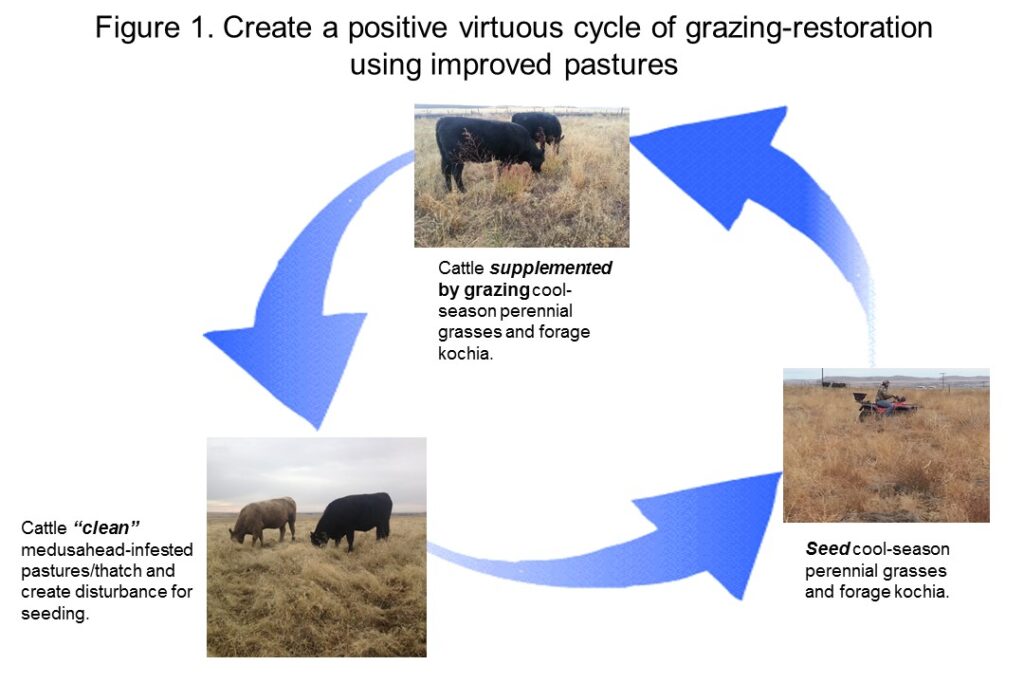
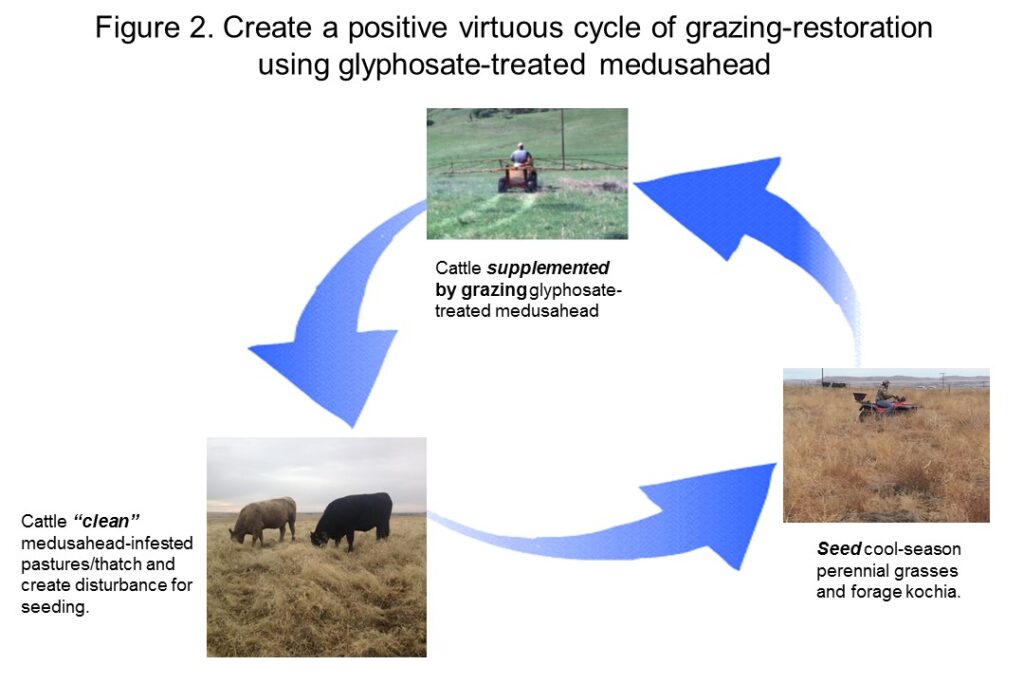
Grazing on Improved Pastures and Revegetation Trial. Fall 2016 and 2017.
Field Trials
Objectives 1 and 2
Grazing on Improved Pastures and Revegetation Trial. Fall 2016 and 2017.
Grazing trials were conducted in two ranches (Branden Spencer: Experimental plots and Luke Mac Rae: Demonstration plots) during 2 consecutive years, 2016 and 2017. Branden Spencer (2016) and Luke MacRae (2017) were significantly involved in this project, from providing ideas, discussing results and participating in outreach efforts. Beef heifers (12) were assigned to two treatments in 6 plots of 0.2 ha each (2 animals/plot): 1) Treatment animals grazed improved rangeland (seeded with forage kochia and Crested and Siberian wheatgrass) for 45 min/day and then they grazed medusahead-infested rangeland (SUP; n=3 plots) on a daily basis for 8 h/day and 2) Control animals just grazed medusahead-infested rangeland for 8 h/day (CTRL; n=3 plots). Individual heifers were focally sampled for successive 5-min periods through the bite count method (Figure 3).
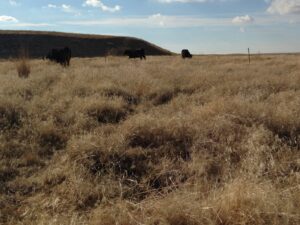
Figure 3. Cattle grazing in the research plots
Grazing and trampling in medusahead-infested plots were used as disturbance agents to seed perennial grasses and forage kochia. Seeding occurred as: 1) seeding prior to grazing; 2) seeding after grazing; and compared to the two different grazing treatments described above (1-SUP and 2-CTRL) and 3-ungrazed plots (Figure 4).
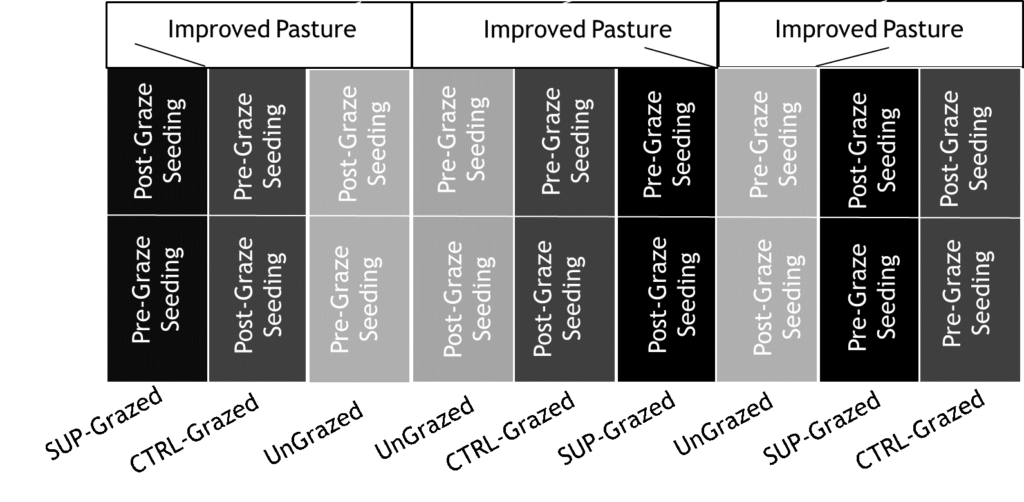
Figure 4. Experimental design for seeding
Two introduced grass species; Hycrest II crested wheatgrass (Agropyron cristatum [L.] Gaertn.), Vavilov II Siberian wheatgrass (Agropyron fragile [Roth] P. Candargy), a native grass cultivar; Sherman big bluegrass (Poa secunda J. Presl), a perennial forb; Small burnet (Sanguisorba minor Scop.), and Immigrant forage kochia (Bassia prostrata [L.] A.J. Scott) were seeded in the fall of 2017 using a broadcast seeder attached to an ATV at a rate of 13.4 kg ha-1 (Figure 5). Seeding establishment was assessed in 2018 using clip and weigh biomass sampling, drop-point intersect, and frequency grid methods.
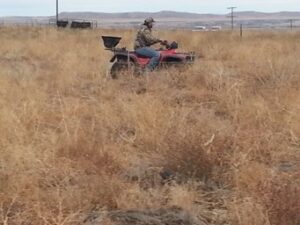
Figure 5. Seeding using a broadcast seeder attached to an ATV
Grazing on glyphosate-treated medusahead.
A) Cattle preferences for glyphosate-treated medusahead: Effects of herbicide rate. Spring 2017
This study assessed wether glyphosate modifies the nutritional environment by increasing the nutritional quality of medusahead and if cattle respond by increasing their preference for the treated weed under different herbicide rates.
The study was arranged as a randomized complete block design consisting of four blocks established within a 97-ha pasture. Each block contained seven plots (3 x 15 m) with an untreated control plot, three plots treated with glyphosate in the form of its potassium salt at a low (236 g ae ha-1), medium (394 g ae ha-1), and high rate (788 g ae ha-1), and three plots treated with glyphosate in the form of its isopropylamine salt at a low (236 g ae ha-1), medium (394 g ae ha-1) and high rate (788 g ae ha-1). Cattle began grazing the 97-ha pasture 3-wks after glyphosate treatment and had unlimited access to the glyphosate-treated plots for 144 days. Biomass was collected prior to glyphosate application, 3-wks post-herbicide treatment, and following grazing.
B) Cattle Preferences for Glyphosate-treated medusahead: Separating de effects of glyphosate from the effects of salt present in the herbicide. Spring/Summer of 2016.
This study untangled the influence of glyphosate and salt (KCl) present in the herbicide on preference for glyphosate-treated medusahead by cattle.
Six medusahead-infested plots (0.054 ha each) were divided into three 6 m by 30 m strips and randomly assigned to the following treatments: 1) application of glyphosate (RT 3; Roundup brand) at a rate of 394g ae ha-1, 2) potassium chloride (KCl; adjuvant salt in RT 3) at a rate of 174g ai ha-1, and 3) Control (CTRL, no chemical application). Seven days after treatment, beef steers (n=12) were randomly paired and assigned to each of the 6 plots in a complete randomized design with repeated measures, such that they could select among the three treatment strips during grazing (Figure 6). Animals were allowed to graze from 0800 to 1700 from June 11 to June 18, 2016. Foraging events on medusahead (MH), other grasses (GR) and forbs (F) were measured using the bite count technique at successive five minute intervals per steer for 4 h/d.
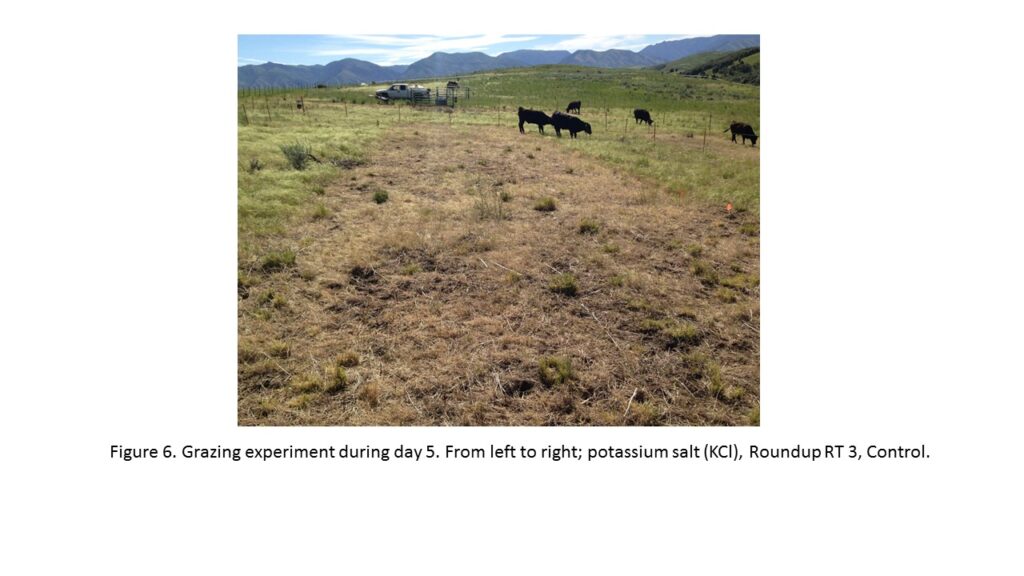
C) Cattle Preferences for Glyphosate-treated medusahead: Separating de effects of glyphosate from the effects of adjuvants. Spring/Summer of 2017.
This study untangled the influence of glyphosate and adjuvants present in the herbicide on preference for glyphosate-treated medusahead by cattle.
Six medusahead-infested plots (0.09 ha each) were divided into five 6 m by 30 m strips and randomly assigned to the following treatments: 1) application of glyphosate+adjuvant (RT 3; Roundup brand) at a rate of 394g ae ha-1, 2) Application of glyphosate at the same rate used in (1) but mixed with KCl; 3) Application of glyphosate without adjuvant or salt at the same rate used in (1), 4) Application of adjuvant only, and 5) Control (CTRL, no chemical application). Seven days after treatment, beef steers (n=12) were randomly paired and assigned to each of the 6 plots in a complete randomized design with repeated measures, such that they could select among the five treatment strips. Animals were allowed to graze from 0800 to 1700 for 7 days. Medusahead removal from the strips was assessed by measuring biomass in the plots before and after grazing.
D) Cattle Preferences for Glyphosate-treated medusahead: Effects of timing of application. Spring/Summer 2018
This study assessed the optimal time to apply glyphosate in medusahead-infested rangeland in order to maximize preference and thus use of the weed by cattle.
Four medusahead-infested plots (0.07 ha each) were divided into four 6 m by 30 m strips and randomly assigned to the following treatments: Medusahead was treated with Roundup RT 3 at 788 g ae ha-1 during 1) early seedling stage (seedlings to 5cm tall); 2) boot stage (seedlings to 10cm tall with awns in boot stage); 3) early reproductive stage (fully emerged seedhead with prominent awns); 4) Control: No RT3 treatment (Figure 7). Seven days after treatment, beef steers (n=8) were randomly paired and assigned to each of the 4 plots in a complete randomized design with repeated measures, such that they could select among the four treated strips. Standing vegetation was be estimated in each plot by clipping prior to herbicide application, prior to and after grazing. Steers were allowed to graze from 0700 to 1800 then penned until the following morning. Activity for all groups was measured using automatic behavior recorders (IceTags). Incidence of foraging events were assessed using focal animals at 5 min intervals using bite count method on medusahead, annual grass, perennial grass, annual forb and perennial forb.
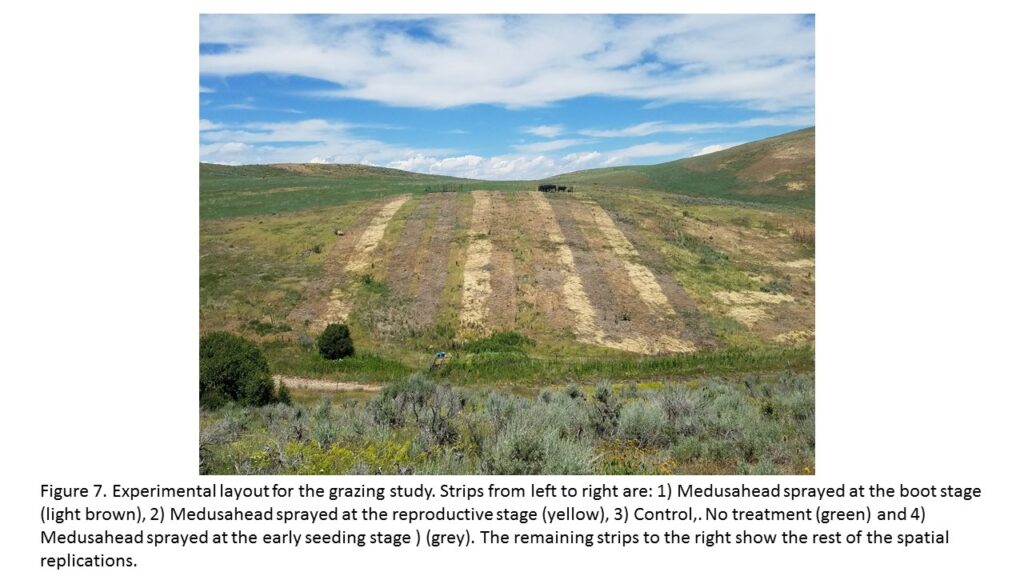
E) Cattle Preferences for Glyphosate-treated medusahead: Exploring fermentation kinetics to understand medusahead preference. Fall 2017.
The objective of this study was to determine the in vitro digestion kinetics of medusahead treated with different herbicide concentrations (788 g ae/ha-1 (High), 394 g ae/ha-1 (Low), and 0 g ae/ha-1 (Control)) at different particle lengths (1, 20, 30, and 40 mm). Medusahead was treated with glyphosate during the late vegetative to early reproductive stage of the plant at two locations, Mantua, UT and Ritzville, WA. In vitro gas production (Figure 8) was measured at 2, 4, 6, 8, 12, 18, 24, 36, 48, 72, 96, and 120 h of incubation, and gas production kinetics was adjusted using a single phasic model with three parameters. Apparent digestible organic matter (DOM) and ash content of the substrates were also measured after incubation. The experimental design was a completely randomized block design with herbicide treatment, particle length and location as fixed factors and four runs as replicates.
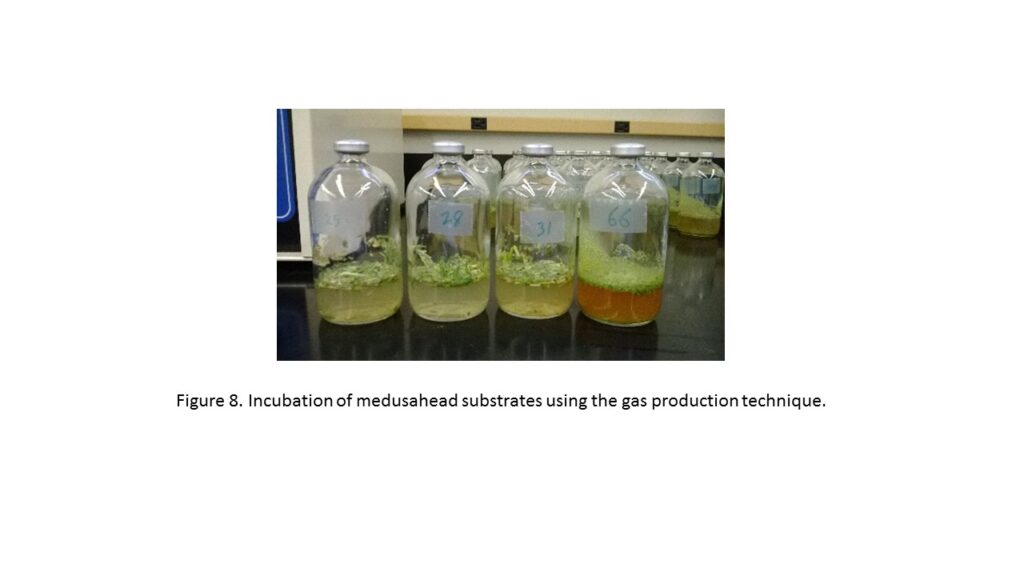
Objective 3
Assess the spatial and temporal spread of medusahead in the region.
Ground analyses were conducted on three ranches from Team Members to understand, relate and identify different land cover types according to the spectral signatures from the National Agriculture Imagery Program (NAIP) aerial images. A multi-scaled approach was then used to develop accurate models that predict continuous fractional cover (fCover) of medusahead in the region (Figure 9). This study integrated GPS field points from three study sites (ranches from Team members) and imagery from two remote sensing platforms, to delineate, model, predict, and validate medusahead cover estimates over 37,000 hectares of rangelands in the Channeled Scabland region of eastern Washington (Figure 9). The predictive performances resulted in a R2 of 0.80 near the training site and a R2 of 0.68 away from the training site.
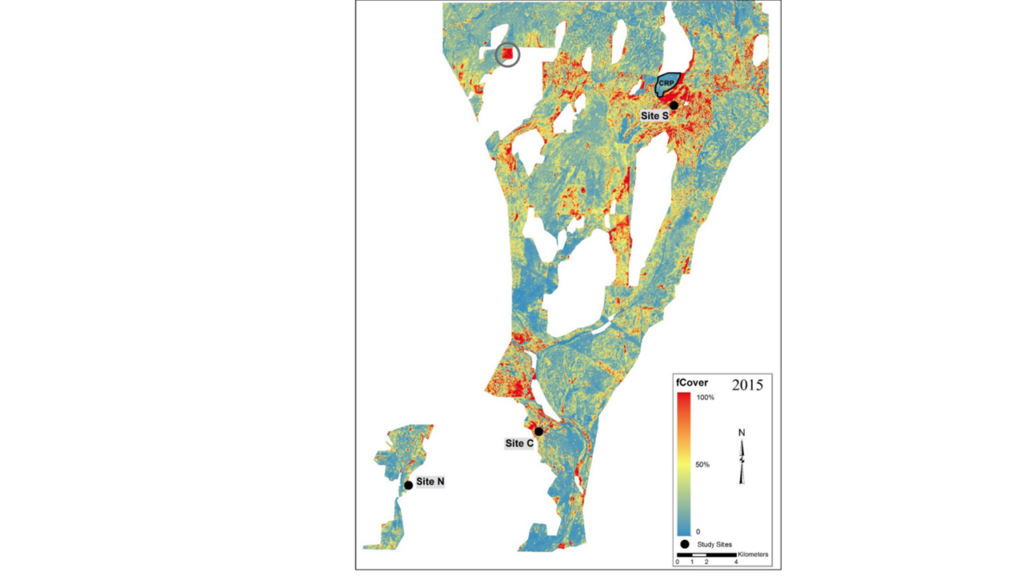
Figure 9. Prediction output of continuous fractional cover (fCover) for the study area for 2015. Circled area represents possible over-prediction due to mustard skeletons
Objectives 1 and 2
Grazing on Improved Pastures and Revegetation Trial. Fall 2016 and 2017.
Results show that grazing the improved pasture (SUP) enhanced the subsequent use of medusahead and thatch in the medusahead-infested plant community relative to the CTRL during the initial part of the study (Figure 10). SUP animals also utilized medusahead in the improved pasture at a very high rate (42.4 ± 0.09% bites/day) and consumed less perennial grasses in medusahead-infested rangeland than CTRL animals (Figure 10). As medusahead was depleted in the medusahead-infested plots, use of thatch increased for both groups and it was similar towards the end of the 8-d period (Figure 10).
Preliminary results show small burnet established and persisted in the seeded areas through the fall of 2018, and that Sherman big bluegrass and Hycrest II crested wheatgrass established in some plots where animals were supplemented with improved pasture (SUP) (Table 1). Trampling before or after seeding did not influence plant establishment (Table 1). Additional assessments will be carried out in 2019 and 2020. Results of this study were presented at the 2018 Society for Range Management Annual Meetings.
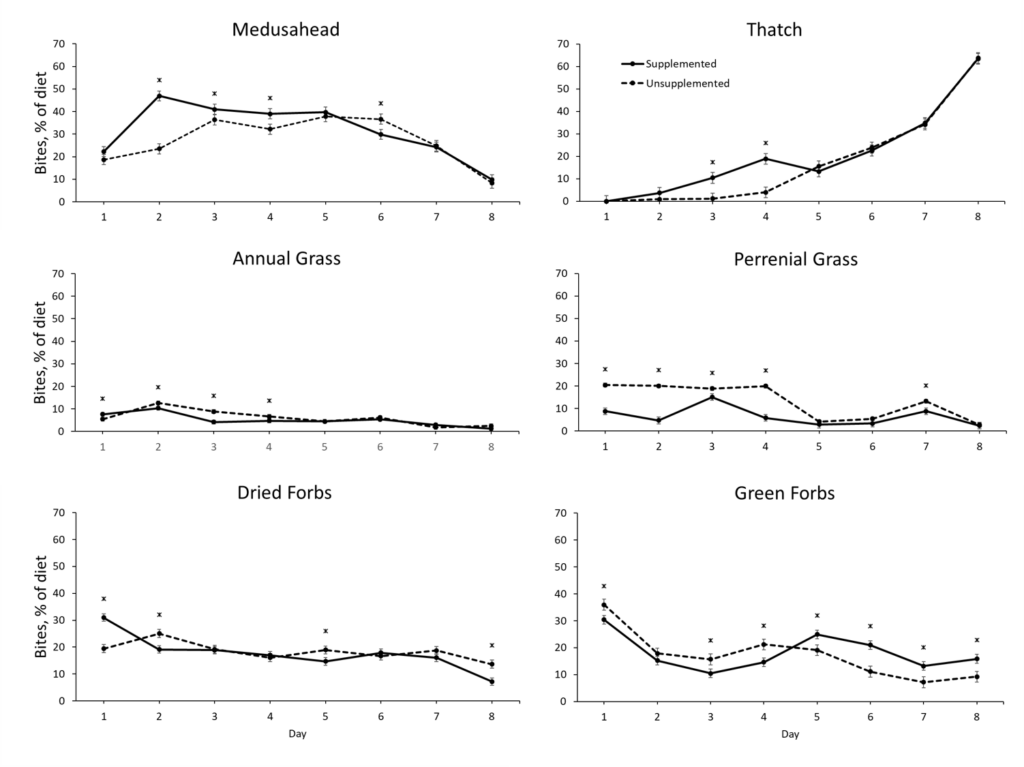 Figure 10. Bites as a percentage of the diet displayed by cattle grazing in an improved pasture before grazing a medusahead-infested pasture (Supplemented) and cattle that just grazed the medusahead-infested pasture (Unsupplemented).
Figure 10. Bites as a percentage of the diet displayed by cattle grazing in an improved pasture before grazing a medusahead-infested pasture (Supplemented) and cattle that just grazed the medusahead-infested pasture (Unsupplemented).
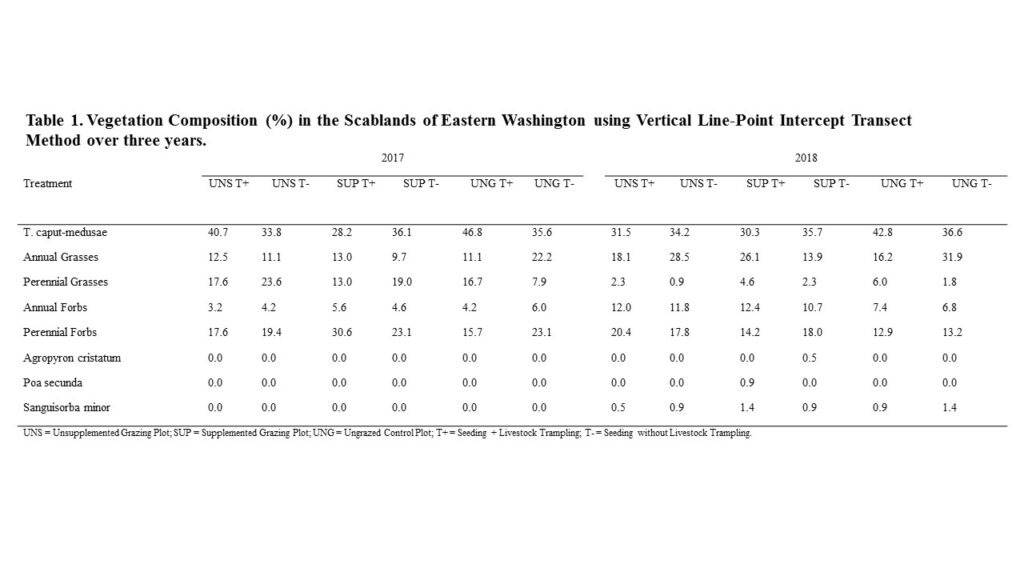
Grazing on glyphosate-treated medusahead.
A) Cattle preferences for glyphosate-treated medusahead: Effects of herbicide rate. Spring 2017
The highest utilization of medusahead occurred at the highest glyphosate application rate (P < 0.05; Figure 11) with no difference between forms of glyphosate salt. Glyphosate treatment preserved the water-soluble carbohydrate content of medusahead at levels greater than the untreated control (P < 0.05). Glyphosate treatment assisted in the increased utilization of medusahead by cattle and is a viable option to replace fire for the removal of medusahead and its thatch layer, while increasing the forage value of the weed. Results of this study were presented at the 2018 Society for Range Management Annual Meetings.
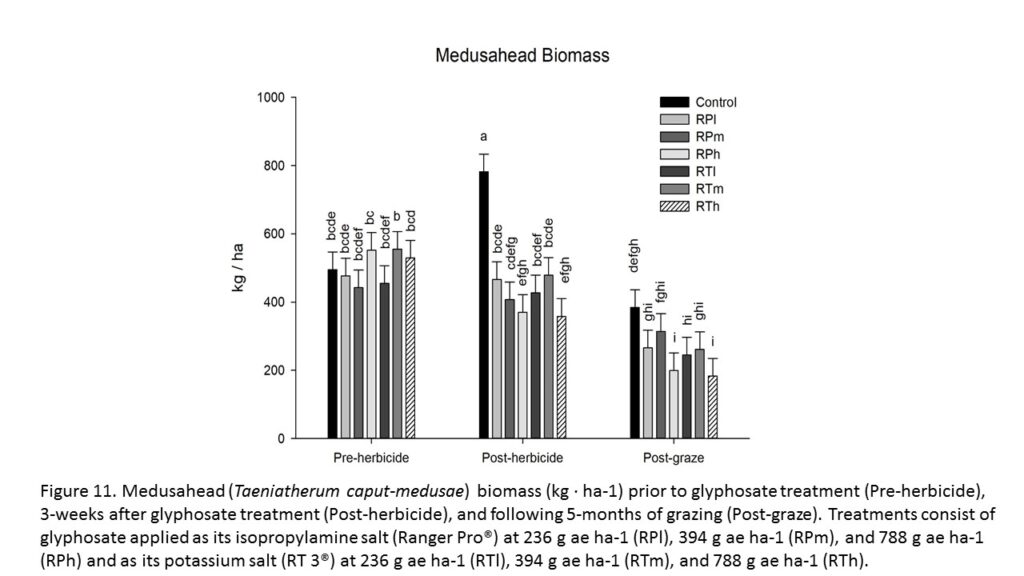
B) Cattle Preferences for Glyphosate-treated medusahead: Separating de effects of glyphosate from the effects of salt present in the herbicide. Spring/Summer of 2016.
Cattle preferred on average grasses (G) (11.5 ± 0.4 bites/min) over forbs (F) and medusahead (MH) (2.7 ± 0.2 and 2.7 ± 0.6 bites/min, respectively; Figure 12). However, bite counts in RT 3 steadily increased for medusahead during the study (Figure 12). The proportion of medusahead removed from RT 3 strips increased steadily from June 12 to June 18 (from 0.02 to 0.5 ± 0.09), a much greater increment than for KCl (from -0.08 to 0.01 ± 0.02) or CTRL strips (from -0.06 to 0.06 ± 0.03), resulting in a greater use of medusahead in glyphosate-treated strips, in particular relative to the KCl treatment (Figure 13). The greater utilization of glyphosate-treated medusahead plants and strips suggests that salt (KCl) is not the variable that explains the preferences observed for glyphosate-treated medusahead in cattle. An integrated approach of herbicide and grazing treatments is an efficient tool to control medusahead spread in rangelands. Results of this study were presented at the 2017 Society for Range Management Annual Meetings.
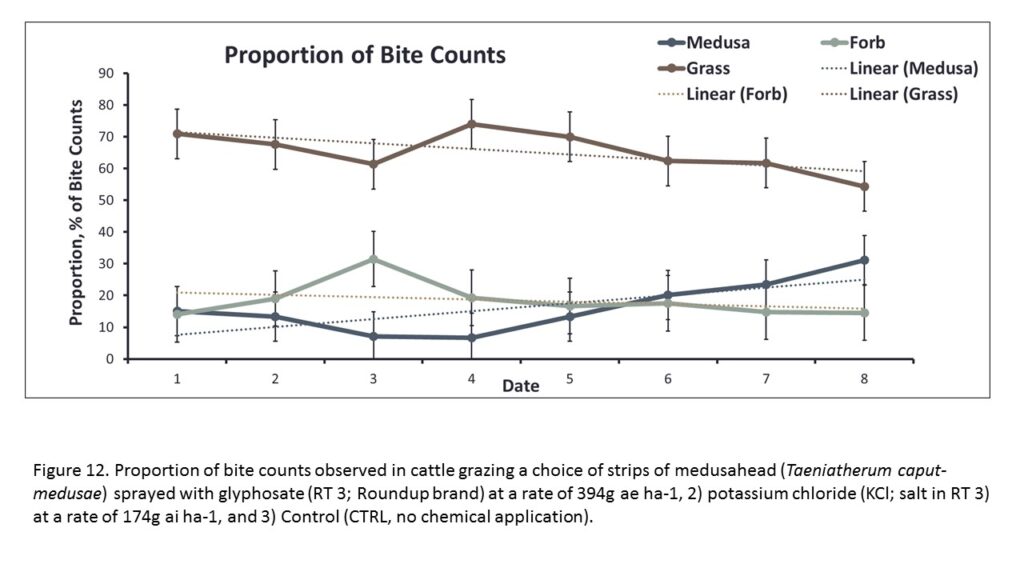
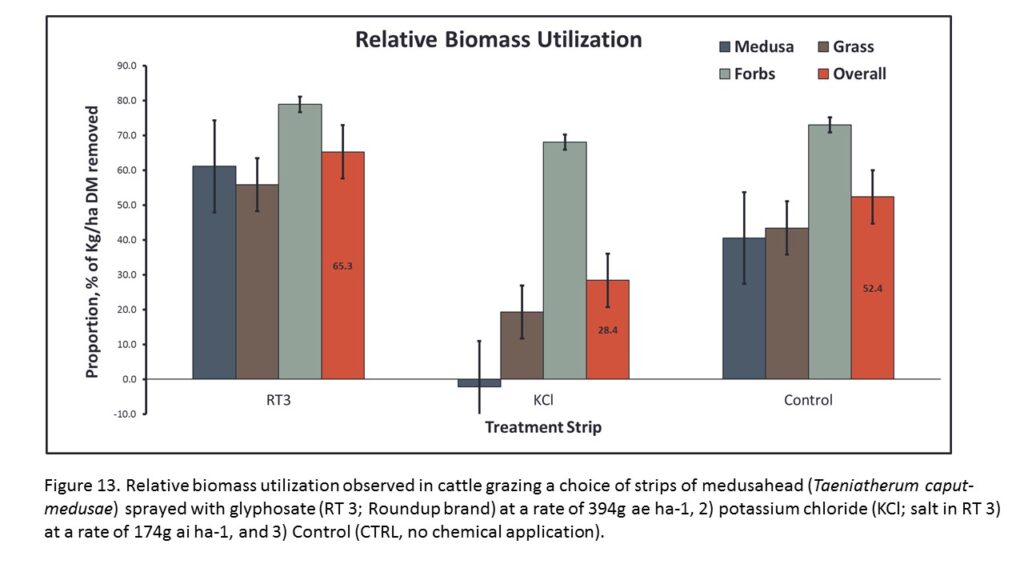 C) Cattle Preferences for Glyphosate-treated medusahead: Separating de effects of glyphosate from the effects of adjuvants. Spring/Summer of 2017.
C) Cattle Preferences for Glyphosate-treated medusahead: Separating de effects of glyphosate from the effects of adjuvants. Spring/Summer of 2017.
Results show cattle removed a much greater % of biomass in the glyphosate-treated plots than in the Control or adjuvant-treated plots (Figure 14), suggesting that the adjuvant in RT3 is not the variable that explains the preferences observed for glyphosate-treated medusahead in cattle.
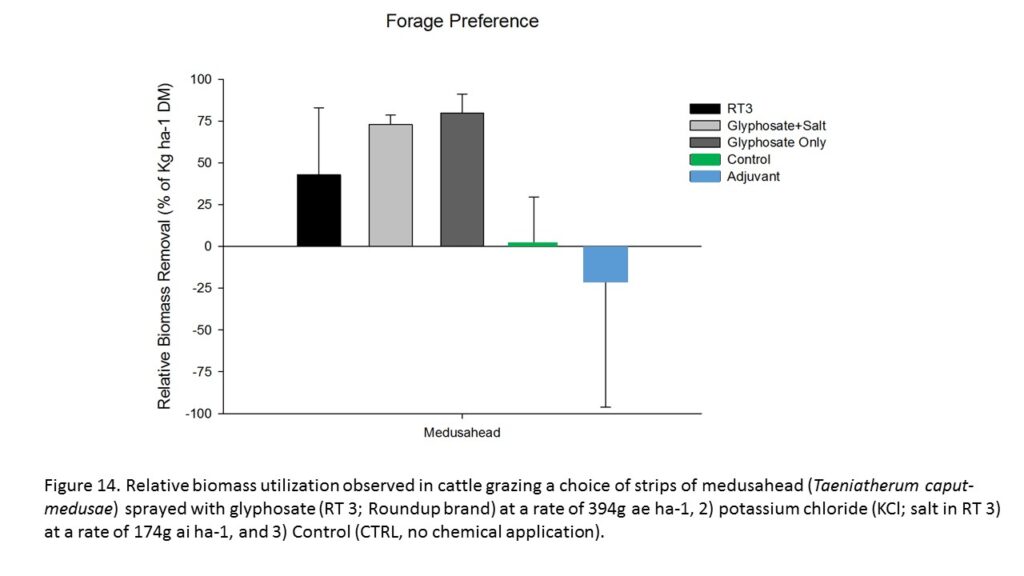
D) Cattle Preferences for Glyphosate-treated medusahead: Effects of timing of application. Spring/Summer 2018
Results show cattle removed and showed the greatest preference for glyphosate-treated medusahead during the early reproductive phenological stage (Figure 15), representing the most effective timing for enhancing utilization by cattle.
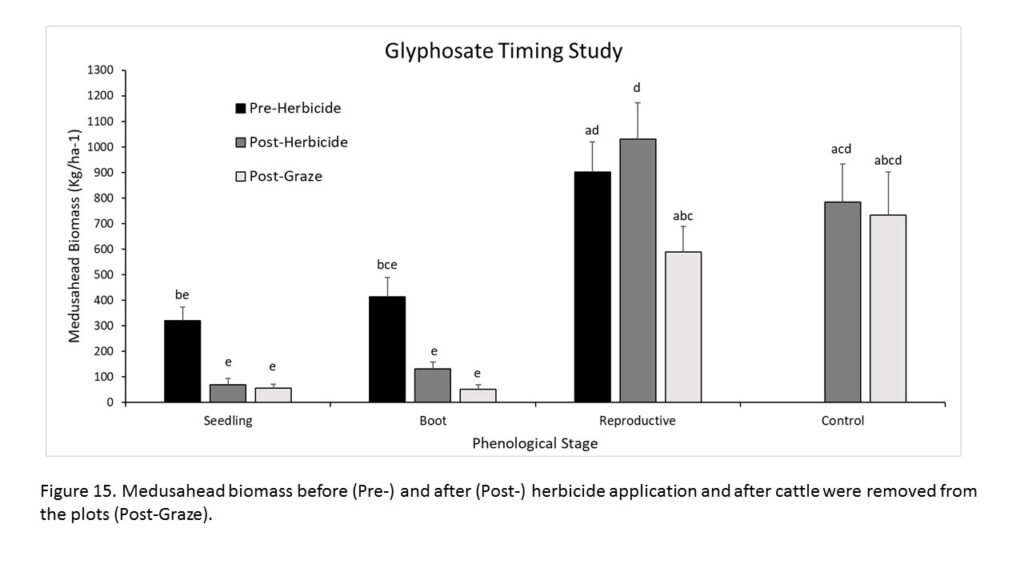
E) Cattle Preferences for Glyphosate-treated medusahead: Exploring fermentation kinetics to understand medusahead preference. Fall 2017.
The smallest particle length, Low herbicide treatment and Ritzville location showed the greatest digestible organic matter and lowest Ash content (Table 2; P<0.05). The potential gas production (parameter A) was the greatest for the High herbicide and 20 mm particle length treatments. Parameter B was the lowest and parameter C was the greatest for 1 mm particles, whereas parameter C was lower for the High and Low herbicide treatments than for Control (Table 2; P<0.05). These results show that herbicide treatments improve the digestion of medusahead (Figure 16), contributing to explain the greater palatability of the treated weed. Results also reveal an inhibitory effect of particle size on medusahead digestibility and a location effect, which may explain differences in medusahead intake across sites. Casey Spackman obtained a Graduate Student Research Opportunity Award to determine medusahead kinetics under this project. Results of this project were presented at the 2018 American Society of Animal Science Meetings.
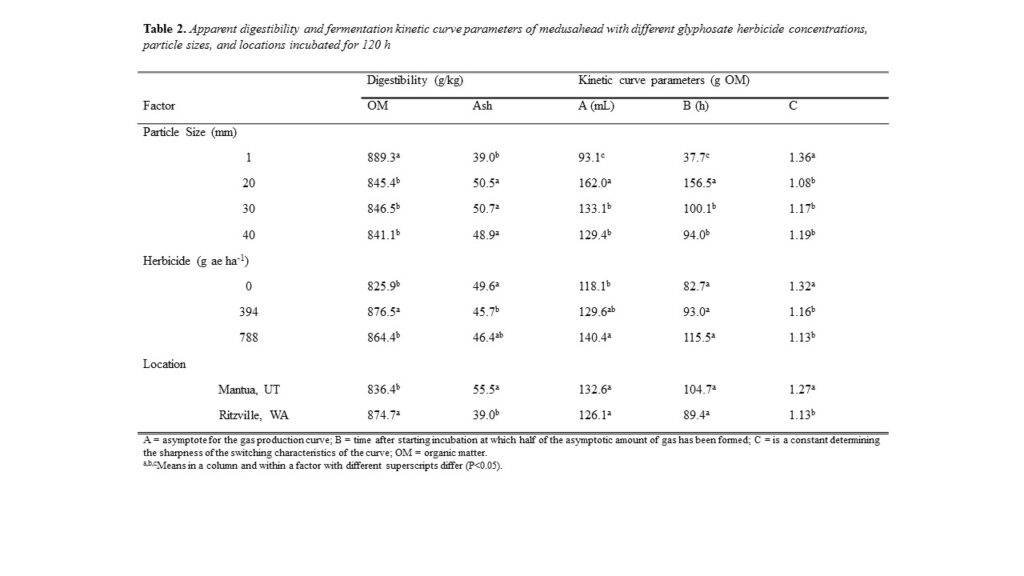
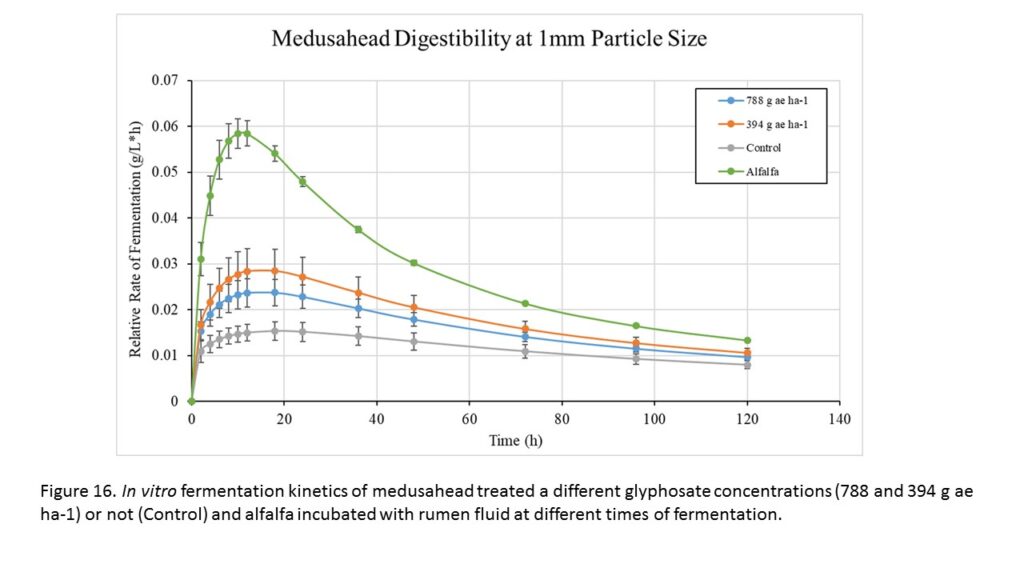
Objective 3
Assess the spatial and temporal spread of medusahead in the region.
By applying the prediction model to annual Landsat images, a dataset was created that contained estimates of medusahead distribution from 1985 to 2016. Trend analysis showed a highly dynamic time line with fluctuations from “high” to “low medusahead cover” years with peak “high” years increasing in magnitude with time (Figure 17). Although a significant trend of mean cover was not detected, the results of the per-pixel assessment characterized the landscape into areas of significant increasing/decreasing trends (Figure 18).
An analysis was conducted to understand some of the drivers for the temporal and spatial patterns of medusahead cover emerging from the datasets described above by identifying “high-risk” dispersal sites and climatic influences through time. Watering points, corrals, and anthropogenic structures were identified to be “high-risk” dispersal pathways that should receive high priority in controlling the additional spread of medusahead (Figure 19). Additionally, this study identified climate variables and periods of the year which could represent constraints for the expansion of the weed across the landscape. Precipitation during January-March, June, as well as temperatures in May represent key periods and events which affected medusahead cover on the temporal dataset of this research (Figure 20).
Finally, a management framework - based on invasion level estimated by the spatial dataset that predicts continuous fractional cover (fCover) of medusahead (Figure 9) - was used to characterize the landscape into strategy areas. The framework included three management strategies (prevention, early detection, and rehabilitation) and suggested associated management actions. Each pixel of the study area was classified into three bins based on user-defined thresholds. Each pixel was categorized into either prevention (0-5%), early detection (5-25%), or rehabilitation (25-100%) areas for the region (Figure 21).
The work described in this section led to the development of a MS Thesis.
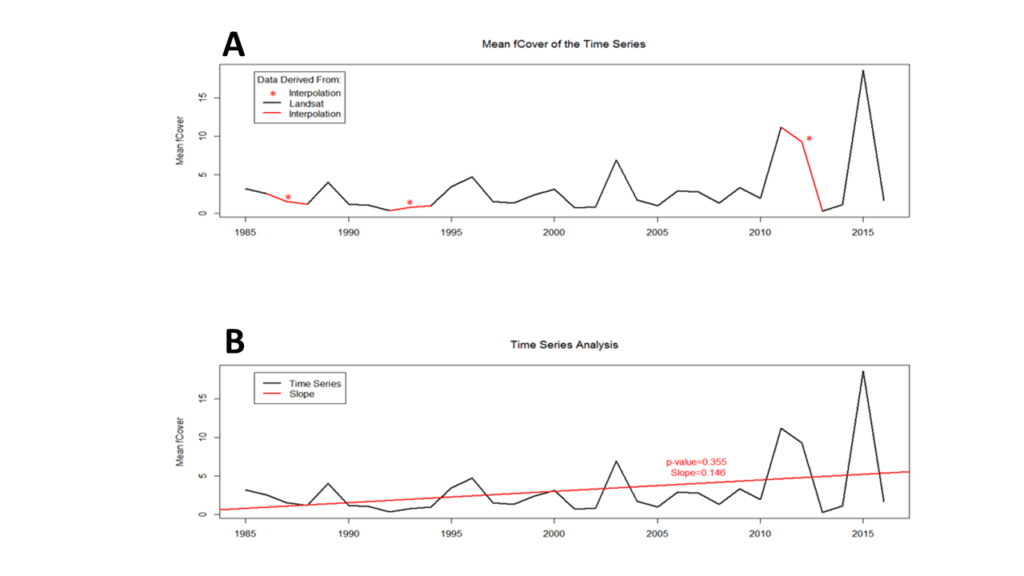
Figure 17. A. Time line of the annual mean fCover from 1985-2016. Red stars represent years that were interpolated due to missing data. B. Trend assessment from the Mann-Kendall test.
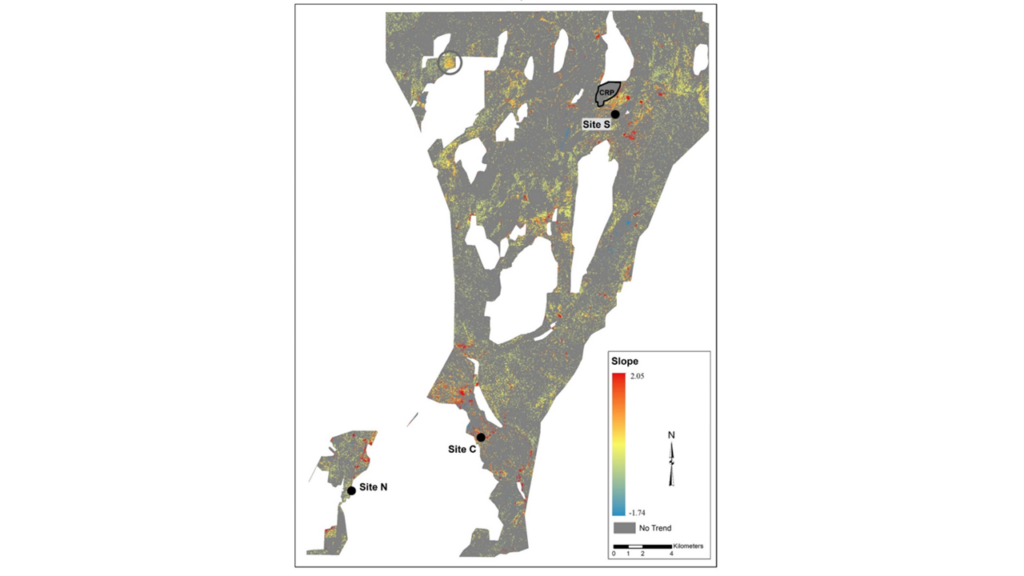
Figure 18. Per-pixel medusahead trends and magnitude of change from 1985-2016.
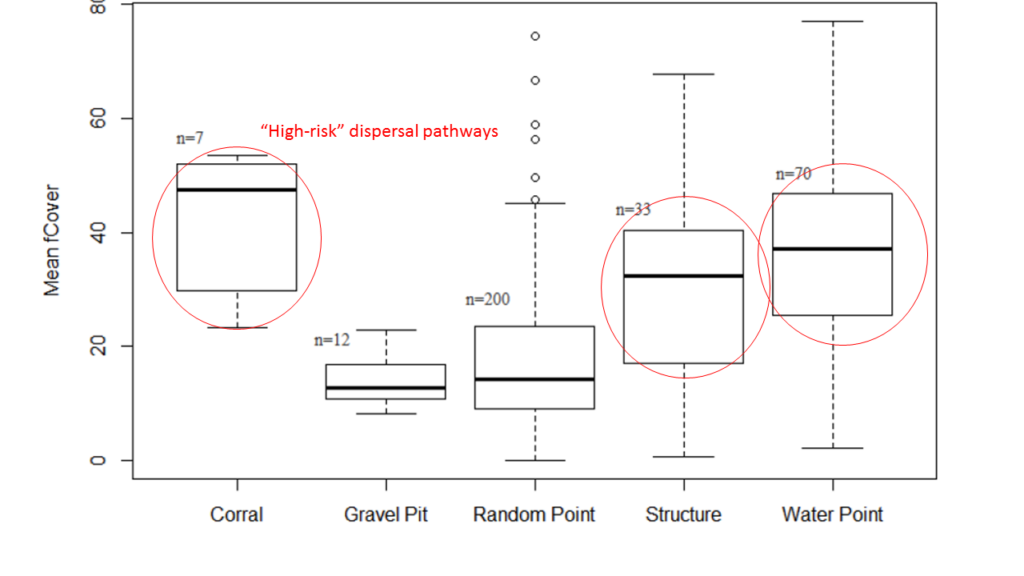 Figure 19. Results of the dispersal site analysis that is showing the differences in mean fCover estimates associated with different features.
Figure 19. Results of the dispersal site analysis that is showing the differences in mean fCover estimates associated with different features.

Figure 20. Graphs showing the strength of correlation and relationship of the six significant climate variables. Each graph is fitted with a lowess line to help show relationships.
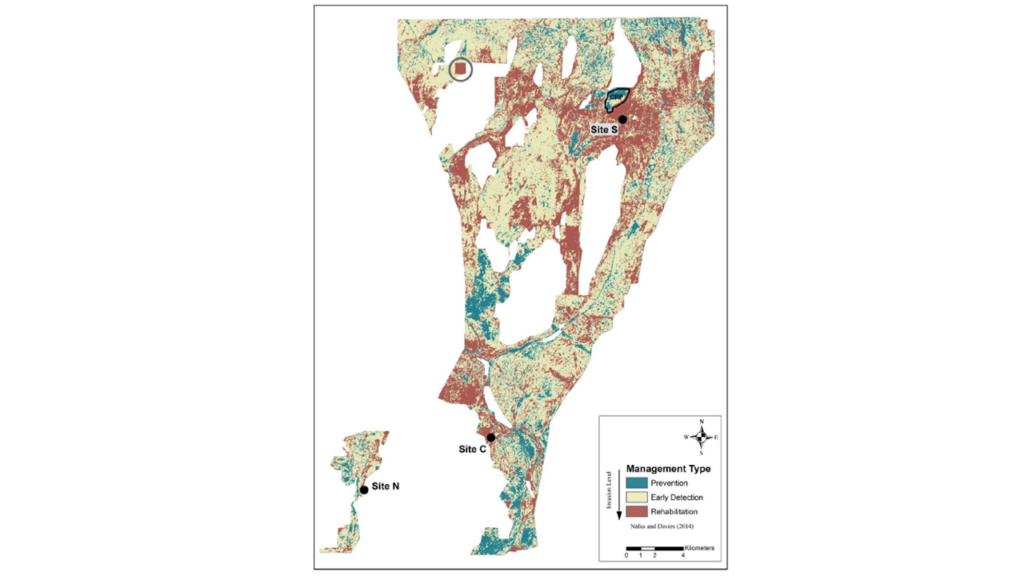 Figure 21. Management Strategies map. Derived by classifying the 2015 continuous fCover dataset using thresholds based on invasion level.
Figure 21. Management Strategies map. Derived by classifying the 2015 continuous fCover dataset using thresholds based on invasion level.
In summary, with Objectives 1 and 2 we learned that it is possible to enhance the use of medusahead by cattle by managing the nutritional environment through: (1) Improved pastures, or (2) glyphosate-treated medusahead. Thus, cattle can be used as a “sustainable tool” to reduce medusahead abundance in medusahead-infested rangelands and for reseeding treatments.
We also learned that increased preference for glyphosate-treated medusahead is triggered by the improvement in nutrition and fermentation kinetics of the weed in the rumen, instead of being promoted by the presence of salt or adjuvant in glyphosate.
Assessing the spatial and temporal spread of medusahead in the region will help managers make quicker and regionally informed decisions aimed at improving the health of western rangelands challenged by medusahead invasion. It can also aid land managers in making quick and informed decisions about grazing, mechanical and/or chemical applications for maximum efficiency in controlling invasive species like medusahead.
Collectively, this research is providing ranchers with low-cost and environmentally sound tools to enhance ecosystem services including biodiversity, improved animal nutrition, welfare and health. Producers in the team are already applying the approach at larger scales in their operations. The knowledge gained from these activities will reduce reliance on season-long grazing and stimulate producers to conduct rotations in their land, which will allow recovery for perennials while combating medusahead invasion through grazing. In addition, producers are being engaged in sustainable restoration efforts which will enhance rangeland health and increase productivity in their operations.
Research outcomes
Education and Outreach
Participation summary:
Field Day. June 28, 2017. A field day was organized by team Mmembers at the experimental sites were the team showed results at research plots and demonstration plots. Producers from the team (Spencer, Coon, MacRae) presented their experiences and findings during field days, as well as scientists (Villalba, Panter, Stonecipher, Jensen), extension specialists (Kruber, Burritt) and graduate students (Spackman, Bateman). The field day was highly attended (45 producers and extension personnel; see pictures below) and results were very well received as producers are looking for sustainable solutions to the problem of medusahead invasion and lupine infestation in their ranches. Fact sheets developed by extension specialists from the Team were provided to the audience.
Flyer developed for the Field Day
Some Pictures of the Field Day
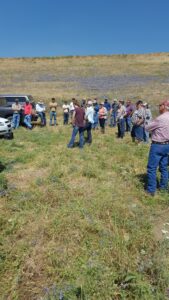
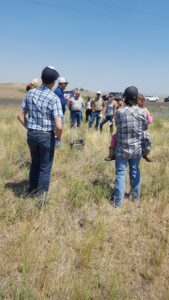
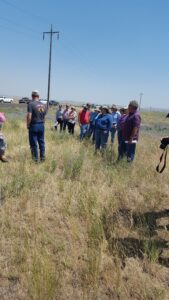
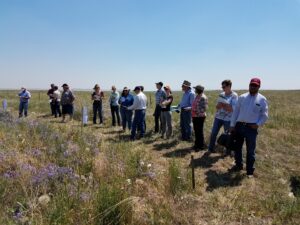
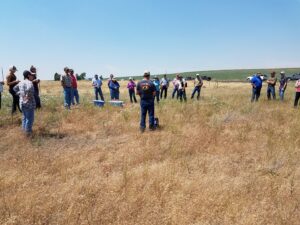
Fact Sheets
Seven Fact sheets were developed by members of the team and are being distributed among producers and during the field day.
2.-Prevent-spread-f-medusahead
6.-Supplemental-Pasture-Medusahead
7.-Restoring_Degraded_Rangeland_Fact_Sheet
Press Articles
Research in the News – Newsletters Articles
Restoring Degraded Rangeland. SARE. Sustainable Agriculture Fact Sheet. August 2017.
Reducing medusahead and preparing he land for restoration. SARE Learning Center. From the Field. https://www.westernsare.org/Learning-Center/From-the-Field/Reducing-Medusahead-and-Preparing-the-Land-for-Restoration.
Burritt, B. 2019. Preventing the spread of medusahead. On Pasture: Translating research and experience into practices you can use now. January 14. https://onpasture.com/2019/01/14/preventing-the-spread-of-medusahead/
Burritt, B. 2019. The Curse of Medusahead Rye. On Pasture: Translating research and experience into practices you can use now. January 7. https://onpasture.com/2019/01/07/the-curse-of-medusahead-rye/
Burritt, B. 2019. A Rancher’s Discovery Shows Promise for Controlling Medusahead Rye On Pasture: Translating research and experience into practices you can use now. February 25.
https://onpasture.com/2019/02/25/a-ranchers-discovery-shows-promise-for-controlling-medusahead-rye/
Website development
A website was developed to disseminate results from the current project
https://extension.usu.edu/medusahead/index
A second website will house a database with all information published on medusahead control and with a link to websites that contain information on medusahead from other states
Invited Presentations:
Villalba, J.J. 2016. Grazing as a tool to control medusahead: Does it work? Sagebrush Ecosystem Conservation: all Lands, all Hands. Joint Conference of the Great Basin Consortium and a WAFWA-Sponsored Sagebrush Science and Management Meeting. Salt Lake City, Utah, February 23-26, 2016.
Villalba, JJ. 2016. Adaptive Toolbox for Medusahead Control: An Integration of Novel and Traditional Approaches. Society for Range Management - Utah Section 2016 Meetings, Richfield, Utah. November 3-4, 2016.
Spackman, C. 2017. Glyphosate Application and Cattle Grazing: An Integrated Approach to Control Medusahead. Society for Range Management - Utah Section 2017 Meetings, The Homestead Resort, Midway, Utah. November 2-3, 2017.
Villalba, J.J. 2017. Ruminants as architects for the management of natural landscapes: an adaptive look to climate change. Extensive Livestock Production in the XXI Century: Foraging Behavior is Sheep as an Adaptation Tool to Climate Change. National Institute of Agricultural Research, Punta Arenas, Chile. December 14, 2017.
Villalba, J.J. 2018. A new paradigm for targeted grazing. Invited seminar given in the context of the program: “Extensive Livestock Production in the XXI Century: Foraging Behavior is Sheep as an Adaptation Tool to Climate Change.” National Institute of Agricultural Research. November 22, 2018. Punta Arenas, Chile.
Spackman, C., Stonecipher, C., Panter, K., and Villalba, J.J. 2018. Medusahead: A Potential Livestock Forage on Rangelands? Restoring the West Conference, Logan, UT, October 16-17, 2018. Invited Presentation.
Burrit, E., Spackman, C. 2018. Lessons from the Cache Valley Medusahead Task Force. Wyoming Medusahead and Ventenata Education Day, Sheridan, WY, June 19, 2018. Invited Presentation.
Burritt, B. 2018. Improving intake of medusahead: Is it possible? Wyoming Medusahead/ Ventenata Field Tour. University of Wyoming Extension Field Tour. June 18-19.
Contributed Presentations:
Spackman, C., Panter, K., Stonecipher, C., and Villalba, J.J. 2016. Grazing rotations on restored land as a new tool for medusahead control. Sagebrush Ecosystem Conservation: all Lands, all Hands. Joint conference of the Great Basin Consortium and a WAFWA-Sponsored Sagebrush Science and Management Meeting. Salt Lake City, Utah, February 23-26, 2016. Poster Presentation.
Coppock, L., Rae Ann Hart, and E.A. Burritt. 2016. Funding most limits our ability to control medusahead in northern Utah. 69th Annual Meeting of the Society for Range Management. January 31 - February 4. Corpus Christi, TX. Oral Presentation.
Bateman, T., Villalba, J.J. 2017. Developing a model that predicts the continuous fractional cover of Medusahead in the Channeled Scablands of Eastern Washington Using Remote Sensing Techniques. 70th Annual Meeting of the Society for Range Management. St George, UT, January 29-February 2, 2017. Oral Presentation.
Spackman, C., Panter, K., Stonecipher, C., and Villalba, J.J. 2017. Glyphosate Application and Cattle Grazing: An Integrated Approach to Control Medusahead. 70th Annual Meeting of the Society for Range Management. St George, UT, January 29-February 2, 2017. Poster Presentation.
Bateman, T., Villalba, J.J. 2018. Spatial and Temporal Assessment of Medusahead Using Remote Sensing. 2018 Annual Meeting of the Society for Range Management. The Nugget, Sparks, NV – January 28-February 2, 2018. Oral Presentation.
Spackman, C., Panter, K., Stonecipher, C. A., and Villalba, J.J. 2018. Grazing Rotations on Restored Land as a New Tool for Medusahead Control. 2018 Annual Meeting of the Society for Range Management. The Nugget, Sparks, NV – January 28-February 2, 2018. Poster Presentation.
Stonecipher, C.A., Spackman, C., Panter, K., and Villalba, J.J. 2018. Glyphosate as a tool to increase livestock consumption of medusahead on annual grass invaded rangelands. 2018 Annual Meeting of the Society for Range Management. The Nugget, Sparks, NV – January 28-February 2, 2018. Poster Presentation.
Spackman, C., Stonecipher, C., Panter, K., and Villalba, J.J. 2018. Exploring the Fermentation Kinetics of Medusahead Treated with Glyphosate at Different Particle Lengths. American Society of Animal Science Annual Meeting, Vancouver, BC, Canada, July 8-12, 2018. Oral Presentation
Spackman, C., Stonecipher, C., Panter, K., and Villalba, J.J. 2018. An Integrated Approach to Control Medusahead Rye Grass. SARE Our Farm, Our Future Conference, St. Louis, MO, April 3-5, 2018. Speed Presentation
Spackman, C., Stonecipher, C., Panter, K., and Villalba, J.J. 2018. Training cattle to graze medusahead and avoid velvet lupine: A new tool to sustain the economic viability of livestock operations in the Western US. Our Farm, Our Future Conference, St. Louis, MO, April 3-5, 2018. Poster.
Stonecipher, C.A., Villalba, J.J., Panter, K.E. 2018. Restoration of rangelands degraded with annual grasses that also contain poisonous plants. 10th International Symposium on Poisonous Plants. Oral presentation. September 16-20, St. George, Utah.
Stonecipher, C.A. 2018. Grazing medusahead (Taeniatherum caput-medusae) after glyphosate treatment. Utah Weed Control Association Annual Meeting. Oral Presentation. February 20-21, 2018. Salt Lake City, Utah.*
Spackman, C., Panter, K., Stonecipher, C., and Villalba, J.J. 2019. Medusahead: a potential livestock forage on rangelands? 72nd Annual Meeting of the Society for Range Management. Minneapolis, Minnesota. February 10-14, 2019. Oral Presentation.
Manuscripts in review and in advanced stage of preparation
Stonecipher, C.A., Spackman, C., Panter, K.E., and Villalba, J.J. Glyphosate as a tool to increase livestock consumption of medusahead (Taeniatherum caput-medusae). Submitted to Weed Biology and Management. Under Review.
Stonecipher, C.A., Panter, K.E., Jensen, K.B., Rigby, C.W., and Villalba, J.J. Seeding medusahead-invaded rangeland following mechanical disturbance on the Channeled Scablands of eastern Washington. (In preparation, to be submitted to Rangelands).
Spackman, C., Panter, K., Stonecipher, C., and Villalba, J.J. Glyphosate application and grazing as an integrated approach to control medusahead. (In preparation, to be submitted to Invasive Plant Science and Management).
Spackman, C., Panter, K., Stonecipher, C. A., and Villalba, J.J. Grazing rotations on restored land as a new tool for medusahead control. (In preparation, to be submitted to Invasive Rangeland Ecology and Management).
Spackman, C., Stonecipher, C., Panter, K., and Villalba, J.J. 2018. Exploring the fermentation kinetics of medusahead treated with glyphosate at different particle lengths. (In preparation, to be submitted to Journal of Animal Science).
Bateman, T., Villalba, J.J., and Ramsey, R.D. A multi-scale approach to predict the fractional cover of medusahead (Taeniatherum caput-medusae) in the channeled scablands of eastern Washington. Submitted to Rangeland Ecology and Management.
Bateman, T., Ramsey, R.D., and Villalba, J.J. Spatial and temporal analysis of remotely sensed rasters containing estimated medusahead cover in the channeled scablands of eastern Washington. In preparation to be submitted to Rangeland Ecology and Management.
Bateman, T., Ramsey, R.D., and Villalba, J.J. Time series analysis of medusahead (Taeniatherum caput-medusae) distributions in the channeled scablands of eastern Washington using predictive modeling of remotely sensed imagery. (In Preparation to be submitted to Rangelands).
Education and Outreach Outcomes
- Grazing/Use of glyphosate combined with grazing